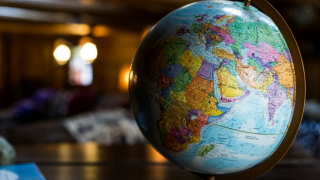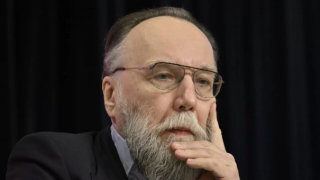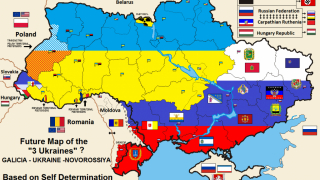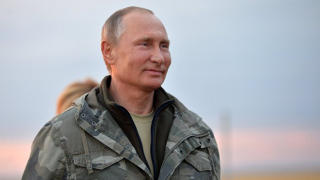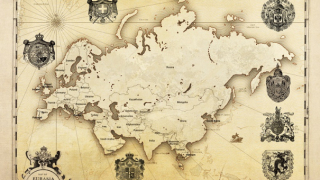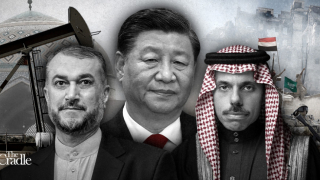The Crimea and the Eurasianist idea as resistance geopolitics
26.04.2014
“I know one thing and I’ll tell you: if Russia survives this period and is eventually saved, it will be as a Eurasian entity and through the Eurasianist idea”, said the Russian ethnographer, historian and geographer Lev Gumilyev in an interview which he gave shortly after the demise of the USSR and briefly before passing away himself in the summer months of 1992. Back then, it were dire years of decay, unraveling and loss of self-esteem in Russia and the rest of the enormous space that used to be the USSR shortly before. Even the existence of the Russian Federation, the USSR’s core entity, had become uncertain with the rise of separatism in the North Caucasian republics of Dagestan and Chechnya and with the rise of local and provincial potentates on which Yeltsin’s Kremlin hardly had any real influence left. So now, Crimea is set to join Russia. How things can turn.
The 1990s trauma
I have been thinking often of Gumilyev and his Eurasianist idea lately, for it indeed explains quite a lot of what had been going on. In brief, it states that the old USSR and the tsarist imperial space that preceded it are essentially grafted in an old cultural sphere in which Slavic and Turkic cultures, Orthodox Christianity, and Sunni and Shi’ite Islam have been cohabiting and interacting for centuries. The core of this sphere, of this ‘great space’ as the Russian political scientist Alexander Dugin calls it, is Russia which, indeed, geographically spreads out over the European and Asian continents and has, through the adoption of Byzantine Christianity in the 980s – after contact first established with Greek bishops on the Crimea by the way – and its incorporation in the system of the Khanate of the Golden Horde (1240-1502), is anchored in the Orient as well as in the West. The whole notion that Russia thus forms a separate sphere around which crystalizes a greater Eurasia, seems also to be present and well alive at the grassroots up to this day.
In a survey conducted among the Russian population in spring 2007 for example, the thesis that Russia is a Eurasian entity in its own right with its own societal and developmental ways, was agreed upon by almost three-quarters of the respondents.[1] Of course, it is more an indicator yet it’s also reflecting a reality. In a similar but much more recent survey last year about the question how Russia will look like in fifty years’ time, the largest share of respondents after the ‘don’t-know/no-answer’ category answered, that its technology and sciences will be quite similar to that of the West but that Russian society and culture will be entirely different from it.[2] Furthermore, as another survey conducted last fall learns, the share of those in Russia who regret the demise of the USSR is high: 57 percent, understandably higher among age categories with active memories of that period (which involves still a fair share of people of active age), yet still amounting to up to one-third among the categories of respondents who were not yet born in 1991 or who were too young to have active memories.[3]
The impact of what we could call the ‘1990s trauma’ caused by the dire years following the unraveling and eventually demise of the USSR should really not be underestimated. In a matter of a couple of years, a decent human capital, a high level of social safety, and a fair level of social infrastructure were squandered and destroyed to make way for a particularly rapacious form of capitalism – dubbed ‘market reforms’ by foreign consultants and scores of profiteers – an acute identity crisis, a dramatic demographic downturn and general degradation and loss of status. The mid-nineties were actually the period when I started to work in Eurasia. Back then, I understood already that all this was going to backlash one day. And indeed it did. Since the beginning of this century, not a small part of public opinion and opinion makers and officials blames an abstract ‘West’ – where certainly the US is being increasingly negatively perceived[4] – and, especially, local and regional liberals in Eurasia itself.
Economic great space
So, what are the different fibers still connecting Russia with its wider historical sphere, and with the rest of the region formerly known as the USSR, in particular? Let us first take a look at the economic substructure, starting with foreign trade. Officially, in the year 2013, almost 21 percent of Russia’s overall foreign trade was with other former states of the USSR, without the three Baltic countries. Some three-quarters of its trade within Eurasia was, in that particular order, with Ukraine, Belarus and Kazakhstan. The latter two are also part of both the customs’ union and the Eurasian Economic Community which are being led and promoted by Moscow. Attempts to also integrate Ukraine in these structures actually sparked the protest movement in Kiev last year. Furthermore, more than 50 percent of Russia’s external commerce takes place with the EU, almost 10 percent with China and some 3 percent with the US. Russia’s external trade pattern is thus primarily oriented towards the EU, which also implicates something else by the way: that economies and corporations from the EU need the Eastern European market.
Hence economic sanctions against Moscow will first of all affect an EU which has primarily acted as an extension and aid of the US in the whole episode of the Ukraine crisis. For those keen on stressing the importance of energy policies, well, there is also the position and activities of Gazprom in Eurasia. This parastatal corporation, which is closely connected to the Kremlin, controls about one-third of the world’s production of natural gas and also has interests and activities in other sectors like transport, oil, banking and media. It is actively present in all former Soviet countries including the Baltics who actually depend on it for most of their supply in natural gas. Gazprom also participates, in one form or another, in oil extraction and in upgrading infrastructure in gas- and oil-exporting countries like Turkmenistan, Azerbaijan and Kazakhstan. Gazprom’s sheer weight explains why Russia, together with Iran and Qatar, has taken the lead in mid-2001 in the establishment of the so-called Forum of Gas-Exporting Countries. The structure, which currently has 11 member states and in which Kazakhstan is an observer, is to be a blueprint of some sort of ‘gas OPEC’.
Migrant workers and oligarchs
Let us go back to society and everyday life. One of the most important sociocultural vectors of Russian influence in greater Eurasia is, of course, the Russian language. The historical aversion against it is by far not as strong as it was in the Baltics and Central Europe in the nineties or as it is in Western Ukraine at the moment. Despite the righteous promotion of local or national languages other than Russian in the 1988-91 period, the Russian language still, or again, has official or semi-official status in Ukraine (although its future in ‘rump Ukraine’ is uncertain), Belarus, Kazakhstan, Kyrgyzstan and Tajikistan. The use of Russian in the societies concerned usually goes well beyond the people of Russian origin and ethnicity. Even in countries where it does no longer have official status, such as Azerbaijan and Turkmenistan, it is still the idiom of the political and intellectual elites, part of the more urbanized population segments, ethnic minorities and it often serves as the language of inter-ethnic communication. Its position also sustains the influence of the Russian mass media, popular culture and opinion makers.
A very important binding agent in Eurasia, one situated on the interface of the grassroots and macro-economics, is seasonal as well as permanent labor migration to Russia. The vast majority of some one and a half million of guest workers who officially stayed in Russia in the year 2011 came from other countries of Eurasia. The largest group, some 510,000, were from Uzbekistan. Additionally, in the same year, some 280,000 guest workers were from Tajikistan, 193,000 from Ukraine, 110,000 from Kyryzstan, 80,000 from Moldova, 71,000 from Armenia, 68,000 from Azerbaijan and 53,000 from Georgia. Besides the old USSR countries, the second-largest country of origin of labor migrants in Russia is China. Kazakhstan and Belarus have also become host countries for migrant workers form southern Eurasia.
They visibly form a large portion of the bazaar traders, construction workers, cleaners and maintenance and catering personnel in the metropolises as well as of the seasonal workers in the agricultural sector. Many have double citizenship. The infrastructure of the recent winter games in Sochi, for instance, has largely been built by workers from southern Eurasia and Moldova. This sort of migration feeds a remittance economy, which in countries like Armenia, Moldova and Tajikistan for instance, contributes a large GDP share amounting from 21 to 48 percent. The remittances of the hundreds of thousands of migrant workers, a majority of them men, are a vital financial lifeline for their families and areas of origin. Socially and psychologically, the impact of migration and the remittance economy is a mixed bag. They have revitalized regions but also disrupted local societies, yet do ensure a permanent interaction at the basic popular level within Eurasia.
At the other end of the social pyramid, there is something peculiar going on. A number of industrialists and oligarchs from Uzbekistan, Azerbaijan and Georgia with connections to the upper echelons of power in Russia are based in Moscow or Saint-Petersburg. Through patronizing sociocultural associations and through media, several of them try to build a political base among the diasporas in Russia of their respective countries or origin. On the mid-term, this is important since several of the personalities concerned have ambiguous if not outright tense relationships with the regimes, or with specific personalities or fractions therein, in their respective countries. Personally, I consider it likely that Moscow will try to steer or recuperate regime change in some Eurasian countries – Uzbekistan for example – with unreliable or fractionalized regimes and a large potential for social unrest, before pro-Western of Western-backed figures and networks do so. In this sense, the personalities concerned as well as they movements and networks form ‘replacement elites’.
Military imperialism?
The navy base in Sebastopol was a hotspot and departure point in Russia’s recent intervention in, or, depending on how you look at it, invasion, of the Crimean peninsula. Yet how can one characterize Moscow’s military cooperation with the rest of Eurasia? Since fall 2002, the institutional framework has been the Collective Security Treaty Organization, a sort ‘contra-NATO’ which, beside Russia, Belarus and Kazakhstan, has Armenia, Tajikistan and Kyrgyzstan as its members. Serbia, amongst others, is an observer to the organization. With the exception of Georgia and, increasingly, also Azerbaijan, Eurasia’s respective national armed forces are still psychologically and technically quite oriented towards Russia and purchase most of their military technology and weaponry from it. The Russian armed forces, for their part, have bases and military advisors in Tajikistan, Armenia and Kyrgyzstan. Additionally, they co-manage the space launch facility of Baykonur is Kazakhstan and radar stations in Belarus and, until last year, also in Gabala in Azerbaijan. And since mid-1992, Russia has also a 9,200 strong peacekeeping force in Transnistria, an area seceded from Moldova in 1990. Beyond the territory of the old USSR, Russia has one naval base on the Mediterranean, in the Syrian port of Tartus. To put things in perspective, the US has some nine-hundred bases or other forms of military presence outside of its territory, including in Eurasia.
Since about a decade, Russia has also become, like the USSR used to be, a donor of various forms of development and humanitarian aid.[5] It has channeled its aid, for instance, multilaterally through a number of UN organizations and also donated aid to contexts of high political and symbolic significance, such as Syria, Serbia and the Serbian minority in Kosovo. The bulk of Russia’s foreign aid, however, is destined for Eurasia. During the 2007-13 period, about 57 percent went to Tajikistan, Kyrgyzstan, Armenia and South Ossetia. The latter brings up the existence and the role of Eurasia’s so-called quasi-states, areas that seceded in one form or another between 1989 and 1993, which have many if not all characteristics and attributes of states but that are not recognized as such by other countries and the UN, or only by a handful of countries.[6] There are currently four such entities in the former USSR: the enclave of Nagorno-Karabakh in Azerbaijan, previously-mentioned Transnistria, and South Ossetia and Abkhazia which both seceded from Georgia in the early nineties and officially declared themselves independent after the 2008 South Ossetia War. In some way, the Crimea also fits into this category.[7]
The said four quasi-states largely sustain on an informal economy, on financial and other material aid, pensions and migrant remittances from Russia. In most of these entities, there is also a strong identification with and favorable opinion of Russian among local public opinion. Just like Kosovo, which is in fact a protectorate, is an important pivot and hold of NATO-US presence in the Balkans, they form a core element of Moscow’s presence in greater Eurasia. In that sense, Transnistria, in particular, along with Sebastopol and the Baltic exclave of Kaliningrad (an old part of Prussia which was annexed by the USSR after the Second World War and is still part of the Russian Federation), is perceived to be a necessary outpost of Eurasian resistance on the western frontier against a NATO that is perceived to be increasingly aggressive and expansionist. A few days after the Crimean referendum, the parliament of Transnistria, which like the peninsula has a Russian or at least Russia-speaking majority, proposed to also accede to the Russian Federation.[8]
Bismarck and the ‘neo-USSR’
So, to conclude, Moscow definitely has aspirations in this enormous space between the Baltic Sea and Alaska. But contrary to the American neo-empire these aspirations of dominance are not planetary.[9] Following Russia’s military intervention on the Crimea, which was, amongst others, legitimized by the necessity to protect the peninsula’s Russian population, some suggested that Kazakhstan, with its large Russian minority of about one quarter of the population and in the majority in a number of districts bordering Russia itself, might be next in line. This is quite improbable though. When one looks at the pattern of Russian military intervention over the last few years, one notices that these have taken places in countries – South Ossetia and Georgia, where Russians form barely 1.5 percent, and now Ukraine and the Crimea – which have been the setting of so-called ‘color revolutions’ which eventually largely championed a pro-NATO and generally pro-Western societal and political project.
Much more than something driven and inspired by aggressive expansionism or access to resources, the recomposing of a greater Eurasia is perceived to be a necessary resistance movement against forces and centers of power the eventual aim of which is nothing less than the dismantling of Russia itself, or its reduction to a submissive and obedient entity.[10] To prevent this, a ‘great space’ has to be formed that takes the lead in the formation of the multi-polar world order which has to succeed to American neo-imperial hegemony. There will eventually be no replica of the USSR. The customs’ union between Russia, Belarus and Kazakhstan is definitely meant to be a blueprint for more in-depth integration or reintegration in Eurasia though, quite similar to the way the Prussian Zollverein from 1839 laid the bases for the unification of the German states and principalities which was achieved by Otto von Bismarck by the year 1871. And this design is certainly not less legitimate than the EU, the Gulf Cooperation Council or the US’ free-trade area for the Americas are. Whether the national elites involved, especially those of Kazakhstan, will eventually be willing to transfer power to a supra-national entity in the near future remains to be seen. Yet the perception of a process and threat of externally steered chaos, regime change and further balkanization of Eurasia, and, especially, the objective interests and advantages of a more multi-polar world order could definitely offer the necessary psychological impetus to do so.
[1]Аналитический Центр Юрия Левады-YuriLevadaAnalyticalCentre, «Л.А. Седов: Россия и мир», 2007, http://www.levada.ru/press/2007081001.html
[2]Аналитический Центр Юрия Левады-YuriLevadaAnalyticalCentre, «Россия-2063», 2013, http://www.levada.ru/22-08-2013/rossiya-2063
[3]Аналитический Центр Юрия Левады-YuriLevadaAnalyticalCentre, «Россияне о распаде СССР», http://www.levada.ru/14-01-2014/rossiyane-o-raspade-sssr
[4]Аналитический Центр Юрия Левады- YuriLevadaAnalyticalCentre, «Россияне об отношении к другим странам», www.levada.ru/11-10-2013/rossiyane-ob-otnoshenii-k-drugim-stranam
[5]For more on Russia and a donor of aid, see the study by Oxfam International which is available both in Russian and English at http://www.oxfam.org/en/policy/russia-humanitarian-aid-donor
[6]For a more in-depth examination of quasi-states in the former USSR and elsewhere, see the excellent special issue of Diplomatie: affaires strategiques et relations internationales by Francois Grunewald and Anne Rieu, ‘Entre guerre et paix: les quasi-etats’, Diplomatie: affaires strategiques et relations internationales, №30, 2008.
[7]The first to recognize Crimea’s referendum on independence besides Russia itself were Nagorno-Karabakh, South Ossetia and Abkhazia. Kazakhstan, Armenia and the Bolivarian republic of Venezuela had followed at the time of writing.
[8]Joris Wagemakers ascertains the existence of an outright resistance identity among both the authorities and much of the population of Transnistria. For those interested, see Joris Wagemakers, ‘National identity in Transnistria: a global-historical perspective on the formation and evolution of a ‘resistance identity’’. Journal of Eurasian Affairs, 1(2), 2014, pp. 50-55.
[9]I use the term neo-empire because unlike the Roman, Frankish, Napoleonic and British empires, to name a few examples, it does not consider nor calls itself one and actively maintains an illusion of equality between itself and its subjects.
[10]The fact that well before to the Ukraine and Crimea crisis, the person of Vladimir Putin and Russia on the whole have been demonized for months with almost hysterical international media campaigns supported by a some transnational corporations, celebrities and foreign parliamentarians about a non-issue like the arrest of a nihilist rock band, and about the so-called persecution of homosexuals, has certainly strengthened this perception.


